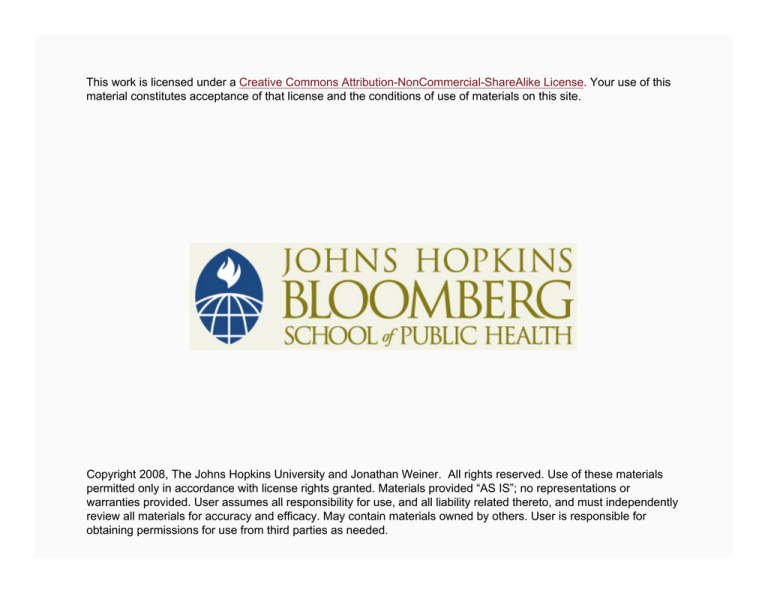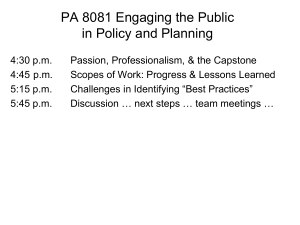
This work is licensed under a Creative Commons Attribution-NonCommercial-ShareAlike License. Your use of this
material constitutes acceptance of that license and the conditions of use of materials on this site.
Copyright 2008, The Johns Hopkins University and Jonathan Weiner. All rights reserved. Use of these materials
permitted only in accordance with license rights granted. Materials provided “AS IS”; no representations or
warranties provided. User assumes all responsibility for use, and all liability related thereto, and must independently
review all materials for accuracy and efficacy. May contain materials owned by others. User is responsible for
obtaining permissions for use from third parties as needed.
Health Policy and the Delivery of Health Care:
Introduction and Private Health Plan Case Study
Jonathan P. Weiner, DrPH
Johns Hopkins University
Objectives
To explore the relationships between public health,
population health, health policy, and medical care delivery
To facilitate an interactive policy-analysis case study related
to population-based health care
To expand the Bardach policy analysis framework by
considering
− Policy-related evaluation and program development
− Private (nonpublic) organization contexts
− Overlap with other related paradigms
3
Objectives (Continued)
To highlight some “evidence-based” tools and decisionmaking frameworks that may be useful to policy analysis
Ultimately, to contribute to your effectiveness as a publichealth “activist”
4
Section A
Definitions and Case Study Introduction
Some Definitions
Population health—a comprehensive framework for
understanding and improving the health and well being of a
defined population
Public health—societal actions to improve health; its core
functions relate to assessment, assurance, and policy setting;
many view public health as being the domain of government
agencies or their agents
Medical care—health care services provided to individual
patients, generally in response to, or in anticipation of, acute
or chronic illness
Health policy—the planning, development, and
implementation of interventions designed to maintain and
improve the health of a group of individuals
6
Some More Definitions
“Evidence-based”
− Public health attempts to rely on scientific empiricism
and analysis to accomplish the assessment, development,
and assurance functions
− Medicine applies scientific empiricism to help guide
clinical decisions of providers and delivery systems
− Health policy attempts to maximize the use of empirical
research, evaluation, and structured analysis as key inputs
into the policymaking process
7
A Population-Based Health Policy Framework
Stronger evidence/knowledge development
Measure
population
health status
Analyze
determinants
of health
Base decisions
on evidence
—Health status
—Determinants
—Interventions
Analysis of
health issue
Priority
setting
Source: Adapted from the Public Health Agency of Canada.
Multiple
strategies
Goals
—Improve health
of population
—Decrease healthstatus inequalities
Increase
Public
Accountability
investments involvement for outcomes
Intersectoral
collaboration
Taking
action
Evaluating
results
8
Medical Care and Private Health Plans Are Central
Why medical care and private health plans are central to
achieving most U.S. health policy objectives
For the 86% of Americans with health insurance, over 95% of
the health-related resources affecting them are controlled by
their health insurance plan or “managed care organization”
(MCO)
− Of this, more than 95% goes towards medical care
delivery
About 90% of insured Americans are in private (both not-forprofit and for-profit) health plans
9
Key Problems Facing U.S. Health Care Delivery System*
Cost
− Runaway medical inflation (e.g., a 25% annual increase for
small employers is not uncommon)
Access
− Large numbers with unmet needs (e.g., 30–50% of
persons with hypertension or diabetes don’t know it)
− There are significant differences in service use by race
Quality
− Quality of care is far from ideal
* In addition to the #1 issue—the uninsured
10
Some Reasons for This Situation
Little infrastructure to provide coordinated populationoriented care
Evidence-based medicine not widespread
Procedurally focused, fee-for-service specialized care
dominates over organized primary and preventive care
11
Bottom Line . . .
There is great need for the application of population-focused
health policy principles!
12
“U-Care” Case Study
The application of public health policy principles and
methods within a private not-for-profit organization
responsible for the health of 200,000 persons
13
The Case Study Scenario
We are policy/planning/evaluation analysts working for an
executive team at a non-profit managed-care health plan—
“U-Care”
U-Care is part of an “integrated delivery system” (IDS)
consisting of an academic medical center, private doctors,
community health centers, and a network of community
hospitals
14
Case Study Scenario (Continued)
U-Care is paid a fixed amount (i.e., it has a “capitated”
contract) to provide comprehensive care to 200,000
Baltimore-area residents insured by both government and
employee ”benefit” programs
− 100,000 Medical Assistance (Medicaid) recipients: welfare
recipients, “gray area” children on “S-CHIP,” and some
disabled
− 100,000 insured “lives” contracted by large and mid-size
employers in region; most are private sector, some are
government employers
15
The U-Care System
16
Section B
Case Study Task
Our Task
To develop appropriate organizational policies that address
key problems related to the treatment of persons with
cardiovascular disease
− Specifically, hypertension (high blood pressure) and
hyperlipidemia (fatty arteries)
− For more information on population-based
cardiovascular care, go to http://www.cdc.gov/cvh/ and
http://www.cdc.gov/doc.do/id/0900f3ec802720b8
18
The Problems on Which We Will Focus
Many among our population are not receiving adequate care
for early-stage cardiovascular disease
− Majority of our members with early-stage disease are not
under treatment
X Many have not been identified, and others, though
knowing they have disease, have not elected to get
treatment or have not remained in treatment
− For about 50% of the patients under care, “process of
care” standards are not being met (e.g., lipid screening,
recommended drug regimen)
19
Prevention, Intervention, Stages of the Disease Process
Prevention, Intervention, and the Stages of the Disease Process: A Central Framework
Population
interventions
Persons
at risk
Patient
interventions
Early signs and
symptoms
Screening
Population/community
needs assessment
10 prevention
Delivery system
interventions
Disease
Negative
outcome
Disease
management
20 prevention
Treatment of
disease
20
Prevention, Intervention, Stages of the Disease Process
Prevention, Intervention, and the Stages of the Disease Process: A Central Framework
Population
interventions
Persons
at risk
Patient
interventions
Early signs and
symptoms
Screening
Population/community
needs assessment
10 prevention
Delivery system
interventions
Disease
Negative
outcome
Disease
management
20 prevention
Treatment of
disease
21
Our Focus for Today
Population
interventions
Persons
at risk
Patient
interventions
Early signs and
symptoms
Screening
Population/community
needs assessment
10 prevention
Delivery system
interventions
Disease
Negative
outcome
Disease
management
20 prevention
Treatment of
disease
22
Goals of U-Care’s Policy Development Process
1. Maximize health benefit for population
2. Contain costs and enhance plan’s economic viability
3. Ensure equity/ethical practices
4. Administrative feasibility
5. Address constituencies and internal and external “politics”
23
Expanded Version of Bardach
Let me offer an expanded version of the Bardach policy
analysis framework . . .
24
Beyond Bardach
Expanded Bardach
framework
1. Understand/define problem
2. Obtain evidence/data
3. Alternative solutions
4. Develop “criteria” matrix
5. Estimate impact (outcome) of
policy
6. Decision process (consider
trade-offs)
7. Advocate chosen policy
8. Implement, improve, evaluate
(“Beyond Bardach”)
Standard eight-step Bardach
policy framework
1. Define the problem
2. Assemble some evidence
3. Construct the alternatives
4. Select the criterion
5. Project the
outcomes
6. Confront the
trade-offs
7. Decide
8. Tell your story
25
Individual Exercise Context and Goals
The context
− You are on a small team about to join a larger group
meeting with the director of policy, planning, and
evaluation for “U-Care”
− Your objective is to sketch out a few key points to share
with your colleagues
− If you wish, focus on only one problem area
Using the handout/checklist
− Your goal today is to suggest how your team would
address the first three “expanded Bardach” tasks
# 1—Understanding the problem
# 2—Sources of information/evidence
# 3—Developing alternative solutions
26
Section C
Case Study Steps 1–3
OK, Time’s Up!
Let’s debrief . . .
− I am the director of policy, planning, and evaluation at UCare. This is a meeting of senior staff from all units across
our organization
28
1) Understanding the Problem
a) How should we quantify the problem?
− What do we want to know?
I. Members not under treatment
II. Patient’s care below standards
29
1) Understanding the Problem (Continued)
b) What past history might be relevant?
I. Members not under treatment
II. Patient’s care below standards
c) Thoughts about the root causes?
I. Members not under treatment
II. Patient’s care below standards
30
1) Understanding the Problem (Continued)
b) What past history might be relevant?
I. Members not under treatment
II. Patient’s care below standards
c) Thoughts about the root causes?
I. Members not under treatment
II. Patient’s care below standards
31
2) Sources of Information
a) Literature
b) Existing data
c) New data collection
32
3) Alternative Policies/Solutions
a) Where might we find some best practices/benchmarks?
b) How should we go about getting input from stakeholders?
33
3) Alternative Policies/Solutions (Continued)
c) Possible approaches
− Financial incentives
− Information/education
− New IDS-controlled delivery programs
− Collaboration with other community groups or providers
− Mandates/regulations (internal, sponsors, government)
34
3) Alternative Policies/Solutions (Continued)
c) Possible approaches
− Financial incentives
− Information/education
− New IDS-controlled delivery programs
− Collaboration with other community groups or providers
− Mandates/regulations (internal, sponsors, government)
35
Two Potential Policy Alternatives
The U-Care board said we can implement only one major
program in this area, and they indicated that we need to
support the decision process to choose between
1) A comprehensive “community” outreach program
involving education and screening for all members
2) An aggressive “disease management” program focusing
on provider practices and patient compliance (which will
involve administrative interventions and “performancebased” rewards and penalties for provider teams)
36
Homework
For these two alternative policies, use the “Expanded
Bardach” handout to develop an outline of the the key
issues/approaches you would suggest for each remaining
policy analysis stage (#4–8)
During the next lecture, we will emphasize
− Developing decision criteria (see #4 on checklist)
− Estimating impact of policy (#5 on checklist)
− Decision-making process (#6 on checklist)
We will conduct another exercise during which you will
deliberate on #4 above
37








